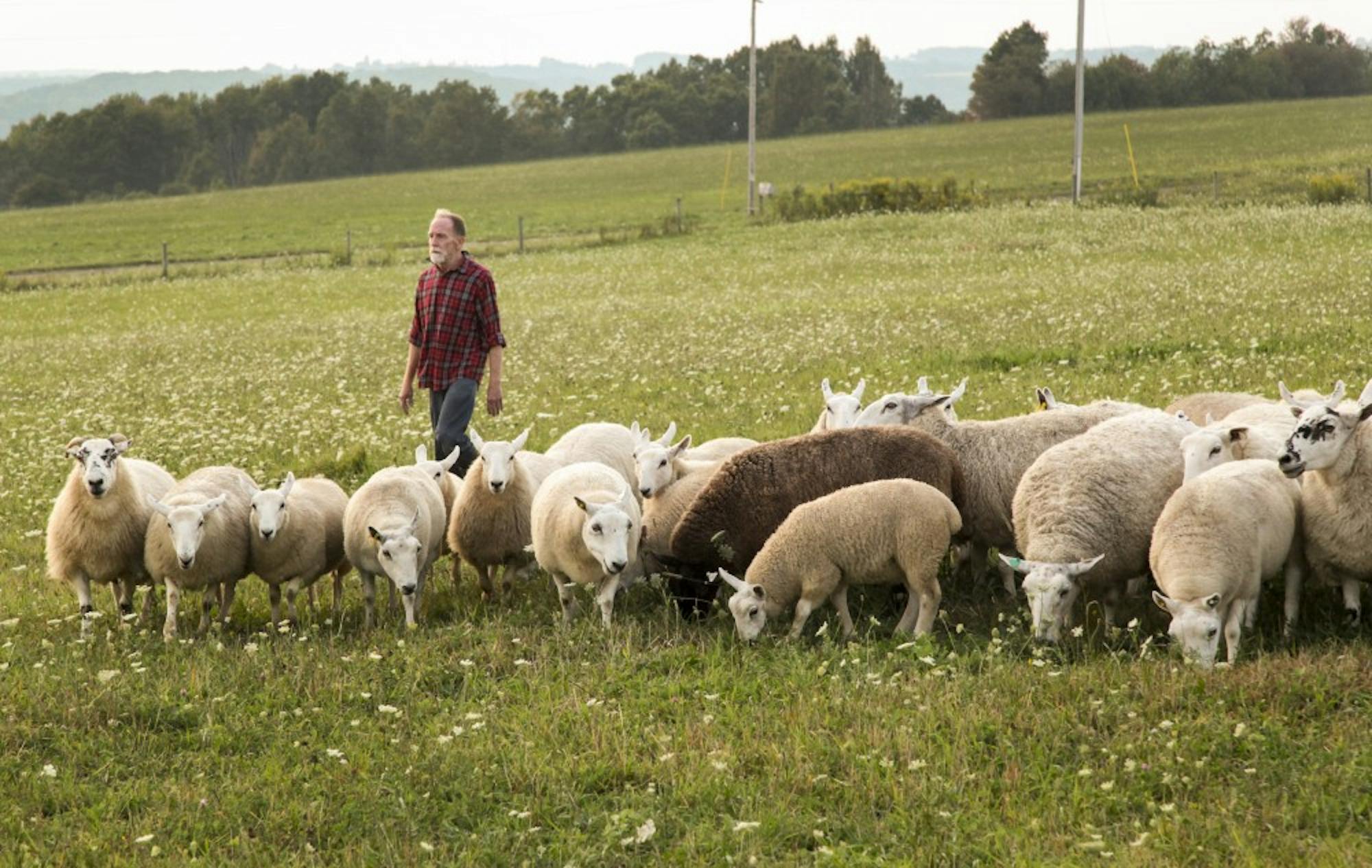Draped in raincoats and ponchos and toting umbrellas of all colors, people gathered yesterday on the Green to see the first public production of “Doggie Hamlet,” a spectacle combining dance, theater and shepherding. An interdisciplinary work featuring human performers alongside sheep and sheepdogs, the piece was created by American dancer Ann Carlson, who also served as choreographer and director for the performance. The show featured three sheepdogs, owned and instructed by Diane Cox, which interacted with sheep from the farm of Steve Wetmore. It also included performers Diane Frank, Peter Schmitz, Ryan Tacata, Imre Hunter-To and Yesenia Major, who interacted with each other and with the animals.
After receiving traditional dance training from a young age, Carlson studied modern dance at the University of Utah, where she graduated magna cum lade in 1976. She later attended the University of Arizona, where she was one of the first students at the university to receive a graduate degree in dance. Despite her traditional background, many of her pieces have included props, speaking and movements, often extending into the world of performance art.
Carlson said she originally came up with the idea for “Doggie Hamlet” when she read “The Story of Edgar Sawtelle” by David Wroblewski. The novel is based on Shakespeare’s “Hamlet” and features a young boy who comes from a line of dog breeders. Carlson said that the story spoke to her because she was also raised around animals. After reading the story, she immediately began to imagine a performance featuring sheep and dogs alongside human performers.
Carlson said when she met Diane Cox, a dog handler and sculpture professor at Alfred University, the whole idea for “Doggie Hamlet” came together. Carlson said that Cox acts almost as a centerpiece throughout the show, directing both the animal and human performers.
The performance begins with an emphasis on the movement between the sheep and one dog being guided by Cox. Later, the other performers begin to take more central roles. Throughout the show, there is a mixture of various art forms ranging from dance to theater to shepherding that intertwine to create an interesting and thoughtful performance.
Carlson said she was eager to come to Dartmouth for the first performances of “Doggie Hamlet” because Margaret Lawrence, the director of programming at the Hopkins Center for the Arts, was so enthusiastic about the project.
Lawrence said she had known Carlson for a while and had asked her to do a show at Dartmouth previously. Once she heard about the initial plans for “Doggie Hamlet,” she was immediately interested.
“I instantly said we need to be a part of this,” Lawrence said.
Lawrence added that she believes the production is particularly interesting to show at Dartmouth because of the agricultural background of the Upper Valley, with its ties to sheep and other livestock.
Although one of the Green’s earliest roles at Dartmouth was as a pasture for cattle, there was a lot of coordination involved in bringing animals onto the modern-day Green. However, after learning about animals and grass maintenance, Lawrence said she was able to bring “Doggie Hamlet” to Dartmouth.
“There [was] a transformation of the Green in a way that I think [was] really remarkable and unforgettable,” Lawrence said.
The Green was indeed transformed into a space for humans and animals alike. Many people came out to see the spectacle, despite the rain.
Rachel McCabe, a resident of Hanover, brought her children with her to the performance.
“My kids love animals, and the idea seemed really interesting to me,” McCabe said.
Carlson said she had hoped that the various elements of “Doggie Hamlet” would attract a diverse audience. Lawrence added that when thinking of events to bring to Dartmouth, she considers the broader Hanover community in addition to the Dartmouth community, particularly in the summer when there are fewer students on campus.
While many people in the audience were Hanover community members, many Dartmouth students also stopped by as they walked across the Green.
Lawrence said that “Doggie Hamlet” is a complicated performance because the story is not handed to the audience on a platter.
“There’s a lot of space that you can bring your own thoughts and ideas to,” Lawrence said.
In addition to not having a specific plot, many of the motions of the performers are improvised or based on a set of rules. Carlson described this movement as a musical score.
“A score not written so much note-by-note but more perhaps phrase-by-phrase,” Carlson said. “And with that phrase they have different images and ideas that they play inside of [it].”
Carlson emphasized that the performers’ movements are not set in stone. Their position on the field, for example, can be influenced by the movement of the animals. Other parts are influenced by the audience, such as when Tacata listens and then moves based on what he hears.
After watching a preview of the show, Lawrence said that she was fascinated by the relationships both between dog and sheep and between human and animal. She said that she could feel the tension between dog and sheep due to the predatory relationship between the two animals, but that this the tension was beautiful at the same time. This led Lawrence to contemplate ideas such as space and proximity as the people, sheep and dogs moved around each other.
When talking about the relation between humans and animals, Carlson said she prefers the terms “human animals” and “non-human animals” so that there is less of a hierarchy.
“It rises up our understanding and the way we speak about animals,” Carlson said.
Carlson added that there is an evolving understanding of animals and their intelligence. By viewing humans as animals, Carlson said that there is no hierarchy among the actors of “Doggie Hamlet.” Rather, she said that each figure plays an equally important role in the performance.
“Doggie Hamlet” was performed twice on the Green yesterday at 4:30 p.m. and 7 p.m. and was free and open to the public.




